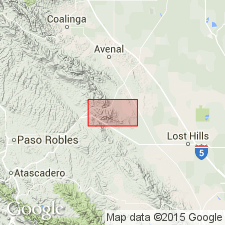
- Usage in publication:
-
- Serpiente sandstone
- Modifications:
-
- Original reference
- Dominant lithology:
-
- Sandstone
- Shale
- AAPG geologic province:
-
- San Joaquin basin
Summary:
Pg. 7 (fig. 3), 26-28, pls. 1, 2. See also 1956 [abs.], Dissert. Abs., v. 16, no. 1, p. 101. Serpiente sandstone. Consists of about 85 percent arkosic sandstone and 15 percent shale. Divided into three members: Huevo = massive conglomeratic, concretionary sandstone with GLYCIMERIS VEATCHI bed, occurs locally at top of formation; Torcido = light-brown finely laminated, fine-grained arkose with hassock structures, conglomerate at top contains BACULITES CHICOENSIS, SUBMORTONICERAS CHICOENSIS, TRIGONIA sp.; Avila member (new). Thickness 4,160 feet at type locality. Conformably overlies Aguila sandstone (new) northeast of Johnson Peak and for distance of 2.3 miles northeast of Avila Canyon; at all other places in area an undetermined thickness of basal part of formation is missing where it has been thrust upon other units. In Sawtooth Ridge and Devil's Den synclines, is overlain conformably by Moonlight formation; elsewhere upper contact is fault separating it from Red Man sandstone (new). Age is Late Cretaceous. Huevo is Spanish word for egg and refers to rounded concretions in the unit; Torcido is Spanish word for contorted and refers to contorted bed in the unit. [Hence, Huevo and Torcido are descriptive terms, not formal names.]
Type locality: Serpiente Ridge and vicinity. Pryamid Hills quadrangle, Orchard Peak area which lies principally in northwestern Kern Co., southern CA.
Named from Serpiente Ridge [author's local name for ridge near mouth of Cottonwood Canyon]. Name means "serpent" in Spanish.
[GNC remark (Jan. 20, 2019): subsequent geologists consider Marsh's stratigraphic classification to be of local significance. Most apply Anderson and Pack's (1915) stratigraphic terminology and assign these rocks to the Panoche Formation. See also Panoche.]
Source: US geologic names lexicon (USGS Bull. 1200, p. 3528).
For more information, please contact Nancy Stamm, Geologic Names Committee Secretary.
Asterisk (*) indicates published by U.S. Geological Survey authors.
"No current usage" (†) implies that a name has been abandoned or has fallen into disuse. Former usage and, if known, replacement name given in parentheses ( ).
Slash (/) indicates name conflicts with nomenclatural guidelines (CSN, 1933; ACSN, 1961, 1970; NACSN, 1983, 2005, 2021). May be explained within brackets ([ ]).

